Music
Trailers
DailyVideos
India
Pakistan
Afghanistan
Bangladesh
Srilanka
Nepal
Thailand
StockMarket
Business
Technology
Startup
Trending Videos
Coupons
Football
Search
Download App in Playstore
Download App
Best Collections
Technology

An Indian startup that is attempting to improve the way how millions of people in the nation lease or buy an apartment — by not paying any brokerage — just raised a significant amount of capital to further expand its business.
NoBroker said on Wednesday it has raised $50 million in a new financing round. The Series D round for the Bangalore-based real estate property operator was led by Tiger Global Management and included participation from existing investor General Atlantic. The five-year-old startup, which closed its previous financing round in June, has raised $121 million to date. The new round valued NoBroker at about $325 million, a person familiar with the matter told TechCrunch.
NoBroker operates in six cities in India: Bengaluru, Chennai, Gurgaon, Mumbai, Hyderabad and Pune. The startup has established itself as one of the largest players in the local real estate business. It operates over 3 million properties on its website and serves about 7 million users. It is adding more than 280,000 new users each month, Amit Kumar, cofounder and CEO of NoBroker, told TechCrunch in an interview.
Real estate brokers in India, as is true in other markets, help people find properties. But they can charge up to 10 months worth of rent (leasing) — or a single-digit percent of the apartmentworth if someone is buying the property — in urban cities as their commission. NoBroker allows the owner of a property to directly connect with potential tenants to remove brokerage charges from the equation.
The startup makes money in three ways. First, it lets non-paying users get in touch with only nine property owners. Those who wish to contact more property owners are required to pay a fee. Second, property owners can opt to pay NoBroker to have its representatives deal with prospective buyers — in a move that ironically makes the startup serve as a broker.
NoBroker also offers end-to-end services such as rent agreements, home loans, and movers and packers, for which it also charges a fee. The startup says it uses machine learning to speed up the transactions and make it service low-cost.
The startup processes about $14 million in rent each month, Kumar said. This is increasing by 25%-30% each month, he said. NoBrokerbusiness in Bangalore and Mumbai, two of its largest cities, are already profitable, Kumar said.
The startup will use the fresh capital to expand its business and build more products.It recently launched a community and digital management app to keep a digital log of all the entries — say a Flipkart delivery personnel comes to your house — occurring in a society, and maintain a dialogue with other people in a vicinity. The app also allows users to exchange goods with one another and pay their utility bills, startupexecutives said.
The new financing round is oddly smaller than $51 million NoBroker had raised in June this year. Saurabh Garg, chief business officer of NoBroker, told TechCrunch in an interview that the founding team did not want to dilute their stake in the startup, hence they opted for a smaller round.
NoBroker is competing with a number of players including Proptiger, 99Acres, and heavily backed NestAway, which counts Goldman Sachs and Tiger Global among its investors. NestAway operates in eight Indian cities and has raised north of $100 million to date. Budget hotel startup Oyo, which has already become one of the largest hotel businesses in the world, also operates in NoBrokerterritory with Oyo Living.
But NoBrokerKumar said he does not see Oyo and other startups as competition. Instead, &these other players are some of our largest clients,& he said. Indiareal estate industry is estimated to grow to $1 trillion in worth by 2030.
The business model of NoBroker has also created new local challenges for the startup. Brokers are unsurprisingly not happy with startups such as NoBroker and have grown hostile in recent years. In recent years, they have attacked and harassed NoBroker employees. So much so that the startup had to delist its address from Google Maps.But Kumar said the mindset of people is changing.
- Details
- Category: Technology
Read more: India’s NoBroker raises $50M to help people buy and rent without real estate brokers
Write comment (100 Comments)&Italmost like the Explore Tab that we have on Instagram& said Facebook CEO Mark Zuckerberg in leaked audio of him describing TikTok during an all-hands meeting. But itnot. TikTok represents a new form of social entertainment thatvastly different from the lifelogging of Instagram where you can just take a selfie, show something pretty, or pan around what you&re up to. TikToks are premeditated, storyboarded, and vastly different than the haphazard Stories on Insta.
Thatwhy Zuckerbergcomments cast a dark shadow over the future of the Facebook family of apps. How can it beat what it doesn&t understand? He certainly can&t ignore it. Facebookcopycat Lasso has been installed just 425,000 times since it launched in November, while TikTok has 640 million installs in the same period outside of China. Oh, and TikTok has 1.4 billion total installs beyond China to date.
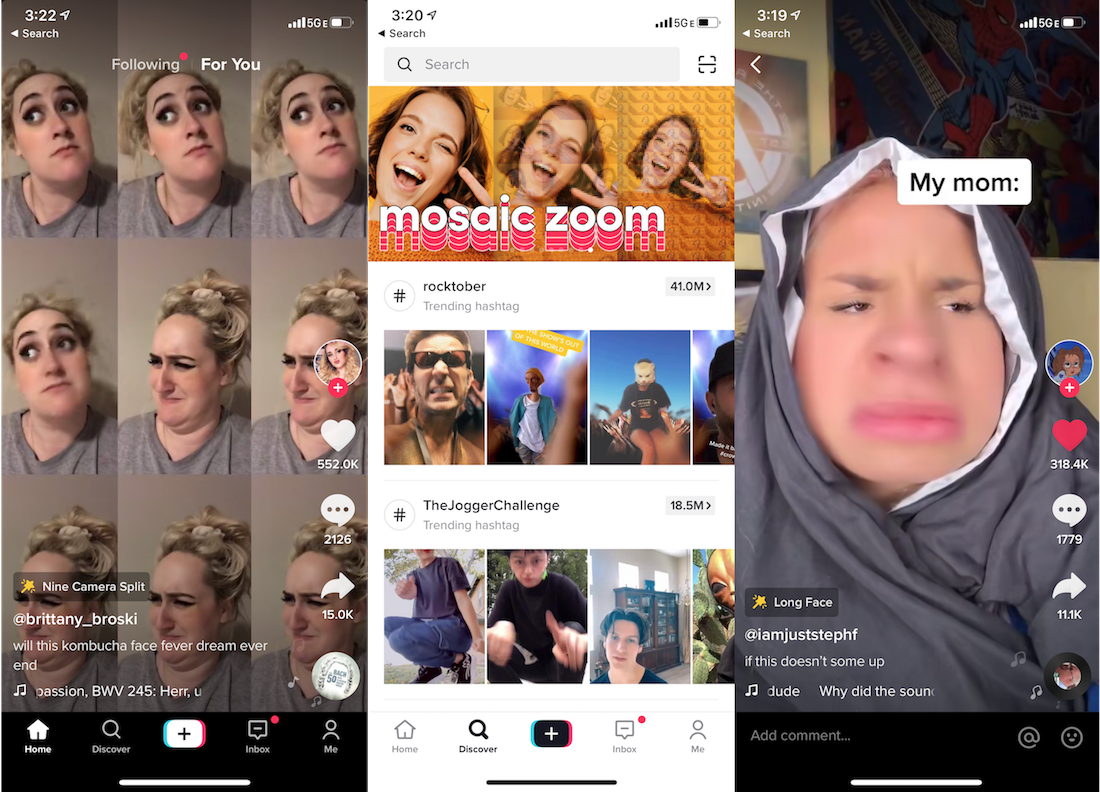
TikTok
Casey Newton of The Verge today published two hours of audio and transcripts from two internal-only all-hands Q-As held by Zuckerberg at Facebook in July. His comments touch on the companyplan to fight being broken up by regulators, especially if Elizabeth Warren becomes President. He thinks Facebook would win, but on resorting to suing the government, he says &does that still suck for us? Yeah.& Zuckerberg also describes how Facebook is working to launch a payments product in Mexico and elsewhere by yearend as Libra deals with regulatory scrutiny.
But beyond his comments on regulation, ithis pigeonholing of TikTok thatmost alarming. It foreshadows Facebook failing to win one of the core social feeds that its business depends on. Perhaps his perspective on the competitor is evolving, but the leak portrays him as thinking TikTok is just the next Snapchat Stories to destroy.
ZuckebergThoughts On TikTok
Herewhat Zuckerberg said about TikTok during the internal Q-A sessions, (emphasis mine):
So yeah. I mean, TikTok is doing well. One of the things thatespecially notable about TikTok is, for a while, the internet landscape was kind of a bunch of internet companies that were primarily American companies. And then there was this parallel universe of Chinese companies that pretty much only were offering their services in China. And we had Tencent who was trying to spread some of their services into Southeast Asia. Alibaba has spread a bunch of their payment services to Southeast Asia. Broadly, in terms of global expansion, that had been pretty limited, and TikTok, which is built by this company Beijing ByteDance, is really the first consumer internet product built by one of the Chinese tech giants that is doing quite well around the world. Itstarting to do well in the US, especially with young folks. Itgrowing really quickly in India. I think itpast Instagram now in India in terms of scale. So yeah, ita very interesting phenomenon.
And the way that we kind of think about it is: itmarried short-form, immersive video with browse. So italmost like the Explore Tab that we have on Instagram, which is today primarily about feed posts and highlighting different feed posts. I kind of think about TikTok as if it were Explore for stories, and that were the whole app. And then you had creators who were specifically working on making that stuff. So we have a number of approaches that we&re going to take towards this, and we have a product called Lasso thata standalone app that we&re working on, trying to get product-market fit in countries like Mexico, is I think one of the first initial ones. We&re trying to first see if we can get it to work in countries where TikTok is not already big before we go and compete with TikTok in countries where they are big.
We&re taking a number of approaches with Instagram, including making it so that Explore is more focused on stories, which is increasingly becoming the primary way that people consume content on Instagram, as well as a couple of other things there. But yeah, I think that itnot only one of the more interesting new phenomena and products that are growing. But in terms of the geopolitical implications of what they&re doing, I think it is quite interesting. I think we have time to learn and understand and get ahead of the trend. It is growing, but they&re spending a huge amount of money promoting it. What we&ve found is that their retention is actually not that strong after they stop advertising. So the space is still fairly nascent, and theretime for us to kind of figure out what we want to do here. But I think this is a real thing. Itgood.
To Zuckerbergcredit, henot dismissing the threat. He knows TikTok is popular. He knows itgrowing in key international markets Facebook and Instagram depend on to keep user counts rising. And he knows his company needs to respond via its standalone clone Lasso and more.
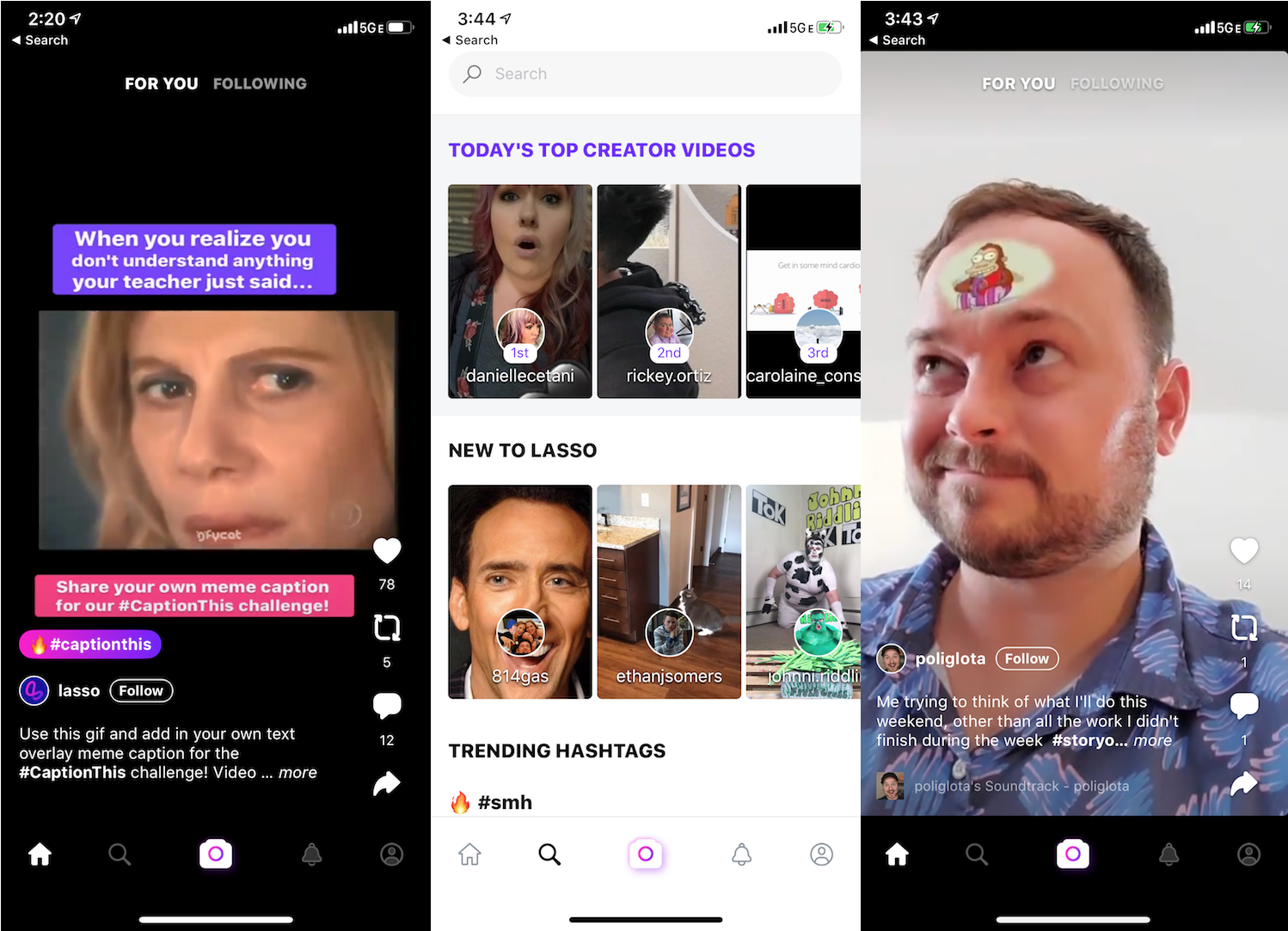
Lasso
But while TikToks might look like Stories because they&re vertical videos, and TikTok might algorithmically recommend them to people like Instagram Explore, ita whole ‘nother beast of a product and one that may be harder than it seems to copy.
To crystallize why, letrewind to Snapchat. With the launch of Stories, it started to blow up with US teens. Facebookattempts to clone it in standalone apps like Poke and Slingshot never gained traction. In fact, none of Facebookstandalone apps have succeeded unless they splintered off an already-popular piece of Facebook like chat and users were forced to download them like Messenger. It wasn&t until Zuckerberg stuck his clone of Stories front-and-center atop Instagram and Facebook that Snapchatuser count went from growing 18% per quarter to shrinking. There, Facebook used the same strategy laid out in Zuckerbergcomments — push its good-enough clone in countries where the original isn&t popular yet.
But Facebook was fortunate because Stories really wasn&t that dissimilar to the content users were already sharing on Instagram — tiny biographical snippets of their lives. Snapchat CEO Evan Spiegel had originally invented Stories as a vision of FacebookNews Feed through the lens of an ephemeral camera. All users had to know was &I take the same videos, but shorter and sillier, posted more often, and then they disappear&. The concept of Instagram and Facebook didn&t have to change. They were still about telling friends what you were up to. Choking off TikTokgrowth will be much more complicated.
Why TikTok Is Tough To Clone
TikTok isn&t about you or what you&re doing. Itabout entertaining your audience. Itnot spontaneous chronicling of your real life. Itabout inventing characters, dressing up as someone else, and acting out jokes. Itnot about privacy and friends, but strutting on the world stage. And itnot about originality — the heart of Instagram. TikTok is about remixing culture — taking the audio from someone elseclip and reimagining the gag in a new context by layering it atop a video you record.
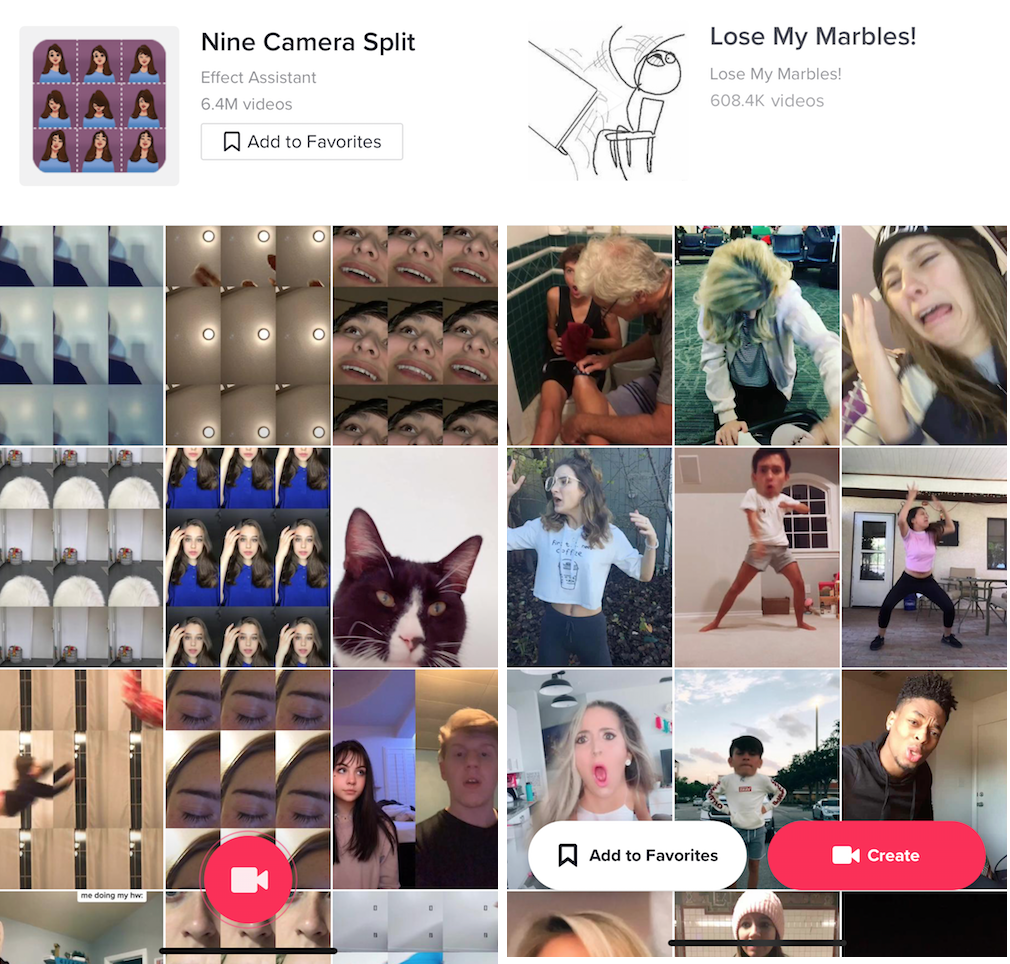
That makes TikTok distinct enough that it will be very difficult to shoehorn into Instagram or Facebook, even if they add the remixing functionality. Most videos on those apps aren&t designed to be templates for memes like TikToks are. Insta and Facebooksocial graphs are rooted in friendship and augmented by the beautiful and famous, but don&t encompass the new wave of amateur performers TikTok elevates. And since each post to the app becomes fodder for someone elsecreativity, a competitor starting from scratch doesn&t offer much to remix.
That means a TikTok clone would have to be somewhat buried in Instagram or Facebook, rebuild a new social graph, and retrain users& understanding of these apps& purpose…at the risk of distracting from their core use cases. This leaves Facebook hoping to grow its standalone TikTok clone Lasso which TechCrunch scooped a year ago before it launched last November. But as we&ve seen, Facebook struggles growing brand new apps, and that effort is further hindered by its increasingly toxic brand and sheen of uncoolness. Nor does it help that Facebook must divert development resources to comply with all the new privacy and transparency obligations as part of its $5 billion FTC fine and settlement.
The Next Feed
Facebookbest bet is to assess the future value of the ads it could run on a successful TikTok clone and apply some greater fraction of that grand sum to competing directly. Italready made some smart additions to Lasso like tutorials for how to remix and the option to add GIFs as sections of your video. But itstill failing to gain serious traction in the US. While typical videos on the TikTok homepage where I&m spending a few hours a week have hundreds of thousands of Likes, the top ones I saw in my Lasso feed today received 70 or fewer.
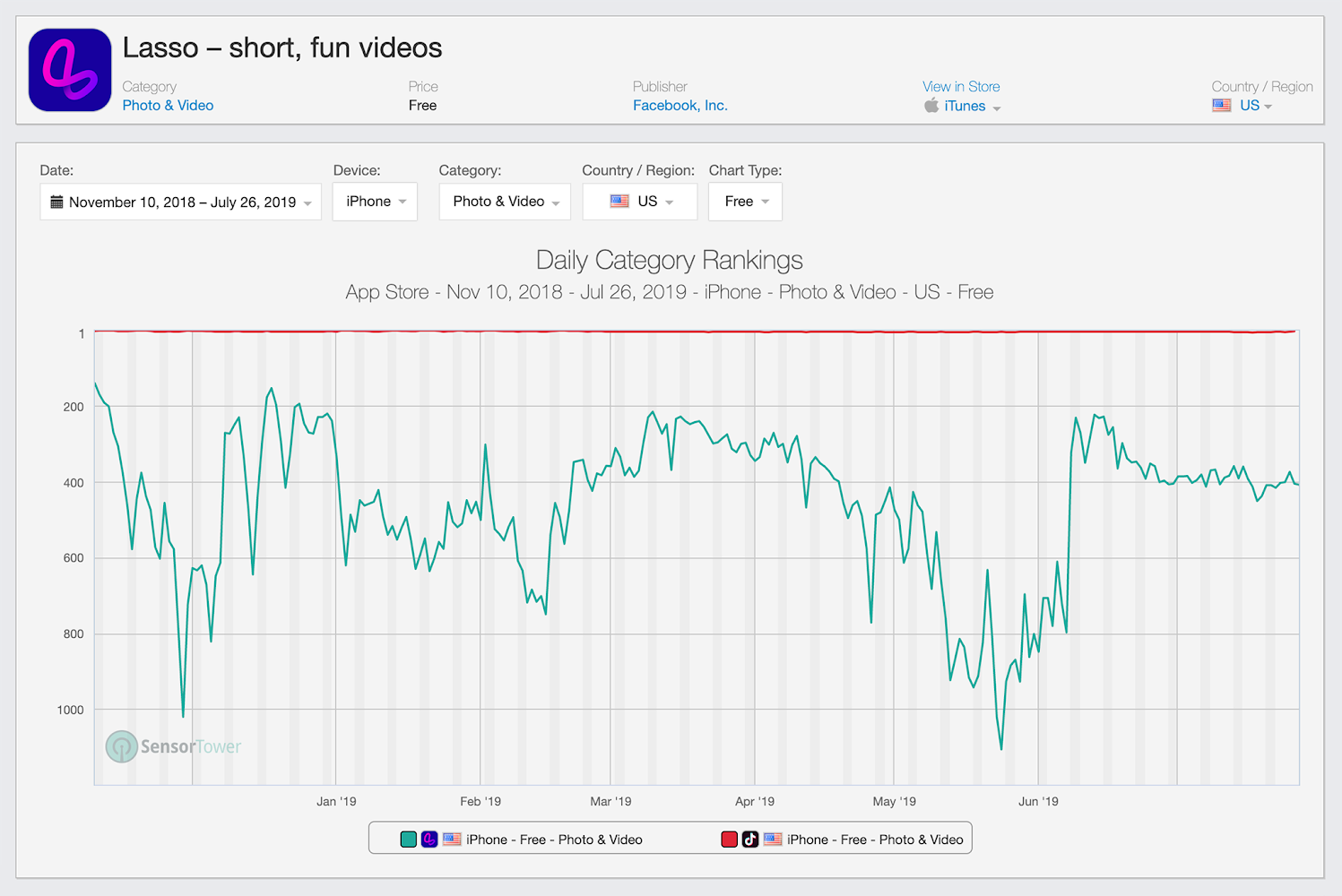
TikTok trounces FacebookLasso in the US iOS App Store charts
I had Sensor Tower run some analysis comparing TikTok with Lasso since its launch last November, and found that Lasso gets 6 downloads for every 1000 for TikTok in the US. Some more stats:
- US Total Downloads Since November: Lasso & 250,000 // TikTok & 41.3 million
- US Downloads Per Day Since November: Lasso & 760 // TikTok & 126,000
- Average US Google Play Social App Chart Ranking: Lasso & #155 // TikTok & #2
Beyond the US, Lasso has only launched in one other market, Mexico in April, where itbeen faring better but could hardly even be considered a competitor to TikTok. Facebook needs to lean harder into Lasso:
- Mexico Total Downloads Since April: Lasso & 175,000 // TikTok & 3.3 million
- Mexico Downloads Per Day Since November: Lasso & 1,000 // TikTok & 19,000
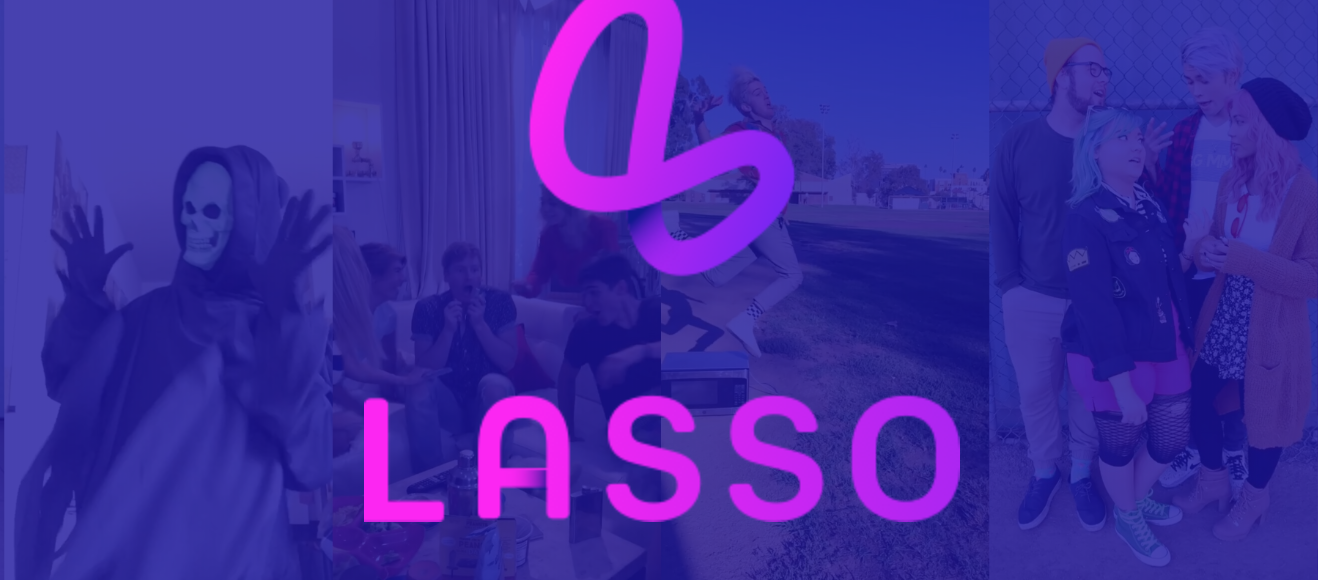
Zuckerberg may need to find a coherent place for TikTok style features inside Instagram and potentially Facebook. That could be another horizontal row of previews like with Stories and/or a header on the Explore page dedicated to premeditated content. Certainly something more prominent than a single button like IGTV that still no one is asking for. One opportunity to best TikTok would be building a dedicated remix source browser into the Stories camera to help users find content to put their own spin on.
Facebook will also need to buy out top TikTok creators to make videos for it instead, and even quasi-hire some of the most prolific video meme or challenge inventors to give users trends to jump on rather than just one-off clips to watch. Its failure to offer IGTV stars monetization has led many to ignore that platform, and it can&t afford that again.
If Zuckerberg approaches TikTok as merely an algorithmic video recommender like Explore, Facebook will miss out on owning the social entertainment feed. If he doesn&t decisively move to challenge TikTok soon, its catalog of content to remix will grow insurmountable and it will own the whole concept of short form performative video. Snapchatinsistence on ephemerality makes it incompatible with remixing, and YouTube isn&t nimble enough to reinvent itself.
If no American company can step up, we could see our interest data, faces, and attention forfeited to an app that while delightful to use, heralds Chinese political values at odds with our own. If only Twitter hadn&t killed Vine.
- Details
- Category: Technology
Read more: Zuckerberg misunderstands the huge threat of TikTok
Write comment (99 Comments)
With so many scandals around the quality of tap water these days, especially in the U.S., many people are turning to bottled water to drink. But this requires single-use plastics that are wreaking havoc on the environment.
One startup in Europe, Mitte, thinks it has the answer: filtering water direct from the tap. It has raised $10.6 million in a seed round. But it hasn&t started manufacturing yet. A new U.S.-based startup thinks it has a competitive solution.
oollee provides people with an unlimited supply of filtered drinking water for a small monthly fee. Itnow raised $1 million in pre-seed funding from investors, including Mission Gate Inc. and Columbus Holdings.
The idea is that with ordinary filters, people forget to maintain them and the water quality deteriorates. With oollee, maintenance and cartridge replacements are included in the monthly fee. To subscribe costs $29 per month (so less than $1 a day).
oollee uses the Reverse Osmosis method, where water is forced across a semipermeable membrane, leaving contaminants behind, which are then flushed down the drain. The clean drinking water collects in a holding tank. Usually, the installation and maintenance of an RO filter is costly and is too cumbersome for a house.
Umit Khiarollaev, CEO and co-founder of oollee says: &The small device connects to Wi-Fi and allows customers to monitor the water. The app reminds users to replace the filter element and lets them order new filters with a single click. Users can also check water condition, volume, temperature, and other factors.& Users also can check water condition, volume, temperature and other factors. The oollee water purifier filters water in four stages, re-introducing essential minerals in the final stage.
Competitors are all major bottled water or smart filter manufacturers, plus delivery services like Nestlé or Alhambra and the tech giant Xiaomi in China with water filters.
- Details
- Category: Technology
Read more: Startup aims to make filtered water an app-driven subscription service in the home
Write comment (94 Comments)
European peer-to-peer car rental service Drivy has a new name. It is now called Getaround, which shouldn&t surprise anyone who has been following Drivyrecent news. Back in April, Getaround announced the acquisition of Drivy for $300 million to expand to Europe. And Drivy is now 100% part of Getaround as the company is unifying its brand across the globe.
While Getaround now operates under a single brand again, there are still two mobile apps — Drivy is called Getaround EU for now. Drivy CEO Paulin Dementhon is now the CEO of Europe for Getaround.
In addition to the new name, Getaround now offers hourly car rentals in Europe just like in the U.S. And thatabout all there is to know.
Overall, there are 5 million Getaround users and 20,000 cars around the world. The company operates in 300 cities across eight countries.
While Drivy started as a sort of Airbnb for cars, the company has slowly evolved to focus less on cars owned by regular car owners. The startup introduced a device that lets you lock and unlock the car using a smartphone. It then started partnering with small companies that own tiny fleets of connected cars that they want to list on the platform.
- Details
- Category: Technology
Read more: Drivy rebrands to Getaround six months after acquisition
Write comment (98 Comments)
Comodo, which bills itself as a &global leader in cybersecurity solutions,& said its forum was hacked.
The admission came in no less than a forum post, which confirmed a hacker exploited a recently disclosed vulnerability in vBulletin, a popular forum software used by Comodo. The flaw, which requires little skill to exploit, allows an attacker to remotely run malicious code on a vulnerable forum. In this case, the exploit was used to dump the entire user database.
Exploit code was released on September 23. Two days later, vBulletin released patches for the software.
But despite claiming in its disclosure that it takes &security very seriously& and is its &highest priority,& the company didn&t immediately patch its forum software. Four days after the patches were released, its forum was hacked.
According to the disclosure, Comodo said the hackers stole usernames, names and email addresses, as well as the userlast IP address used to access the forum. Some social media handles were also stolen in the breach.
Comodo said it has about 245,000 registered forum users.
Itnot the most damaging breach on record, but ita bruising security lapse for a company that claims to be half-decent at this stuff.
This is Comodosecond security snafu this year following another breach involving an exposed password, which allowed a security researcher access to the companyintranet — and access to internal files and documents.
- Details
- Category: Technology
Read more: Cybersecurity giant Comodo can’t even keep its own website secure
Write comment (93 Comments)
Tesla has acquired DeepScale, a Silicon Valley startup that uses low-wattage processors to power more accurate computer vision, in a bid to improve its Autopilot driver assistance system and deliver on CEO Elon Muskvision to turn its electric vehicles into robotaxis.
CNBC was the first to report the acquisition. TechCrunch independently confirmed the deal with two unnamed sources, although neither one would provide more information on the financial terms of the deal.
Tesla vehicles are not considered fully autonomous, or Level 4, a designation by SAE that means the car can handle all aspects of driving in certain conditions without human intervention.
Instead, Tesla vehicles are &Level 2,& and its Autopilot feature is a more advanced driver assistance system than most other vehicles on the road today. Musk has promised that the advanced driver assistance capabilities on Tesla vehicles will continue to improve until eventually reaching that full automation high-water mark.
Earlier this year, Musk said Tesla would launch an autonomous ridesharing network by 2020. DeepScale, a four-year-old startup based in Mountain View, Calif., appears to be part of that plan. The acquisition also brings much needed talent to TeslaAutopilot team, which has suffered from a number of departures in the past year, The Information reported in July.
DeepScale has developed a way to use efficient deep neural networks on small, low-cost, automotive-grade sensors and processors to improve the accuracy of perception systems. These perception systems, which use sensors, mapping, planning and control systems to interpret and classify data in real time, are essential to the operation of autonomous vehicles. In short, these systems allow vehicles to understand the world around them.
The company argued that its method of using low-wattage and low-cost sensors and processors allowed it to deliver driver assistance and autonomous driving to vehicles at all price points.
The company had raised more than $18 million — in $3 million seed and $156 million Series A rounds — from investors that included Autotech VC, Bessemer, Greylock and Trucks VC.
On Monday, DeepScaleco-founder Forrest Iandola posted an announcement on Twitter and updated his LinkedIn account. The Twitter message read &I joined the @Tesla #Autopilot team this week. I am looking forward to working with some of the brightest minds in #deeplearning and #autonomousdriving.&
In Teslapush toward &full self-driving,& it developed a new custom chip designed to those capabilities. This chip is now in all new Model 3, X and S vehicles. Musk has said that Tesla vehicles being produced now have the hardware necessary — computer and otherwise — for full self-driving. &All you need to do is improve the software,& Musk said in April at the companyAutonomy Day.
Others in the industry have balked at those claims. Tesla and Musk have maintained the &improve software& line, and have continued to roll out improvements to the capability of Autopilot. Earlier this month, Tesla released a software update that adds new features to its cars. The update included Smart Summon, an autonomous parking feature that allows owners to use their app to summon their vehicles from a parking space.
- Details
- Category: Technology
Read more: Tesla acquires computer vision startup DeepScale in push toward robotaxis
Write comment (97 Comments)Page 749 of 5614

 20
20





